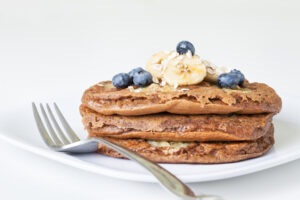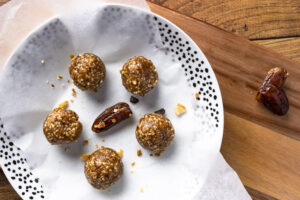When learning about eating well, it’s not uncommon to look at the contents of your kitchen through a new lens and feel a little overwhelmed about the changes to be made. Or, perhaps your cupboards are usually bare because you eat out more than in. Fear not, this is a journey, not a race. You can build on your supplies gradually. Here’s some basics that can help you start making delicious meals that’ll fuel you well.
Dried goods
- Pasta. Quick and easy to transform into a meal with the addition of a tomato sauce, veg and some protein. Choose wholewheat varieties in any shape you fancy. Other options include black bean or lentil pasta which pack extra protein.
- Rice. Cheap and filling, fantastic alongside curry or chilli. Choose brown rice and consider pouches of pre-cooked rice for speed and convenience if needed.
- Noodles. Brown rice or wheat noodles are super speedy and work well in Asian soups and stir fries.
- Oats. Porridge oats are versatile and inexpensive. Eat porridge for breakfast, use them to add bulk to bolognese or stews and make energy rich granola or flapjacks with them. Yum.
Canned goods
Tinned foods have a long shelf life, making them a fab store cupboard staple.
- Veg. Chopped tomatoes are versatile and packed with nutrients. Use for sauces, casseroles, chilli, curry, traybakes and more. Many prefer fresh or frozen veg, but if tins are your preferred option, peas, sweetcorn, and carrots are all good standbys. Avoid products with added sugar and excess salt.
- Fruit. Varieties in juice rather than syrup, are a handy sweet treat that can be eaten from the tin or used in cooking. Peaches, pineapple, and mandarins retain their taste and texture when canned.
- Legumes and pulses. These provide great value and nutrients. High in fibre and protein, kidney, cannelloni, haricot, and butter beans can all be used for chilli, stews and veggie patties. Add lentils to curries or salads. Chickpeas are a tasty addition to Indian or Morrocan recipes, mash them to make falafel or blend with garlic and olive oil for a yummy hummus. Though it’s cheaper to buy dried versions, they require soaking for long periods which means it’s only a sensible option if you’re super organised.
- Fish. Tuna, salmon, sardines, and mackerel can be used in sandwiches, pasta salads and bakes, fish cakes or just spread on toast for a quick meal.
Condiments
- Tomato ketchup. Use in moderation as it can be high in sugar, but sometimes a little squeeze is just what a meal needs.
- Mustard. This packs a flavour punch and tastes great in lots of dishes, from meat to macaroni cheese.
- Vinegar. Balsamic and red or white wine vinegar add acidity to dishes which brightens flavours.
- Peanut butter. Natural, no added sugar peanut butter is nutrient and energy rich. Serve with porridge or toast for breakfast or use it in a satay sauce for a savoury treat.
- Tabasco, sriracha, chipotle and Worcestershire sauce are other handy condiments depending on your taste buds.
Oil
- Olive oil is considered to be the healthiest of plant oils. It has beneficial effects on our gut microbiome and reduces our risk of heart disease and type 2 diabetes. Choose a good quality oil and use a spray bottle to dispense it. This will help reduce the amount you use each time.
Seasoning
- Stock cubes add instant flavour to soups, stews and more. Varieties include vegetable, beef or chicken, choose a low salt option if you can.
- Dried herbs and spices. Add to your collection gradually as you experiment with different flavour combinations. Curry powder, cumin, oregano, rosemary, paprika, dried garlic, and onion powder are all common in many recipes. Chill flakes add an instant kick to meals.
Learning to cook healthy meals takes time and you’ll likely make mistakes and perhaps even burn a few things. Try not to get disheartened. Developing new skills can take time, so be kind to yourself and pat yourself on the back for showing up and making positive changes to your diet and lifestyle. Ask friends or family for guidance if you need to and don’t be afraid to experiment. You’ve got this.




